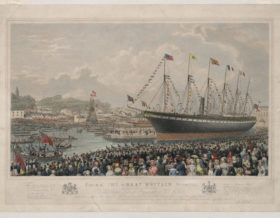People in motion: exiles and opportunities
The process of globalisation was accelerated to an unprecedented degree during the Age of revolution. The late 1700s marked the end of a long process of seaborne exploration that had mapped out the continental geography of the globe, and led Britain and other European countries to trade with, colonise and exploit peoples and lands in different areas of the world. In 1770, Captain James Cook claimed possession for Britain of what he named ‘New South Wales’ (the vast lands and peoples of eastern Australia) and marked the beginning of the British colonisation of Australia.
The revolutions and economic changes of the period resulted in the migration of millions of people – around the globe and within Britain. The American, French, Haitian, and Spanish American revolutions all prompted sectors of their populations to uproot and relocate, creating much spontaneous, disordered, and transnational movement of people that went far beyond patterns that had previously existed. The Transatlantic slave trade continued the forced migration of Africans to the Americas, although numbers eventually dropped with its gradual abolition. In Ireland, the Great Famine led to a mass migration of people to North America, while Scots continued to emigrate from the Highlands as landlords enacted draconian clearances in response to falling prices in traditional commodities. Meanwhile, towns and cities experienced spectacular growth rates as people migrated from rural to urban areas to construct and work in the new mines, factories and transport networks of an increasingly industrialised Britain.
























